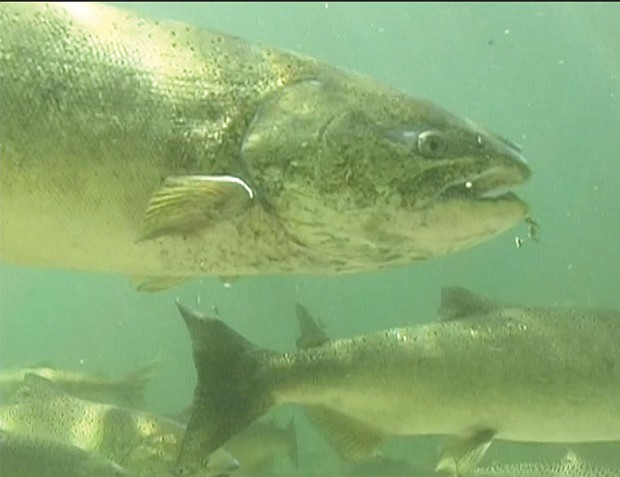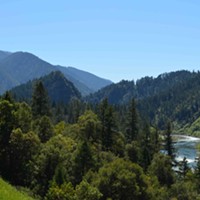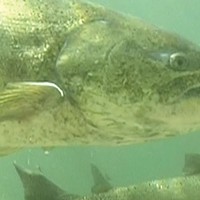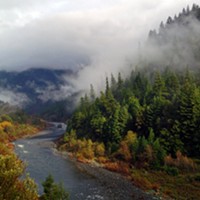News Blog

- Photo by Nathaniel Pennington
- A spring run Chinook in the Salmon River.
And the decision may very well rest in part on a cache of age-old fish bones found inside a cave in the Klamath Upper basin — with some dating back 5,000 years — where the so-called “springers” once swam before a series of dams blocked their way.
By comparing the remnants of those long-discarded catches to modern fish from the Salmon River, a team of University of California at Davis researchers was able to show a genetic mutation found in the today’s springers was evident in the past — an important component in showing the fish are "evolutionary distinct unit" from their fall counterparts.
Using that information, the Karuk Tribe and the Salmon River Restoration Council petitioned for the springers to have their own endangered species protections. Read more about the findings in the Journal’s Aug. 17, 2017 story “One Fish, Two Fish."
“We have known all along that fall Chinook and spring Chinook, or ishyaȃt, are a distinct species,” Karuk Natural Resources Director Leaf Hillman said in a release. “We need western science to catch up to traditional wisdom if we are to make the policy changes necessary to save this part of our culture.”
Read the release from the Karuk Tribe and the Salmon River Restoration Council below:
Orleans, CA – After a 90 day review, today the National Marine Fisheries Services (NMFS) published a notice in the Federal Register stating that the petition filed by the Karuk Tribe and the Salmon River Restoration Council to add Klamath Spring Chinook to the Endangered Species List provides “substantial information” and that “listing may be warranted.”
This finding triggers a 12 month review process by NMFS to reach a final determination.
Last August, a team of researchers at the University of California, Davis led by Dr. Michael Miller, published a report in the journal Science Advances that describes the genetic difference between Chinook (or King) salmon that migrate into rivers in the spring versus the fall. The research provides new insights into salmon evolution and reveals that spring Chinook salmon should be treated as its own evolutionarily distinct unit separate from fall Chinook. Before the age of dams, industrial mining, and clear-cut logging, spring Chinook salmon were the most abundant run of salmon in the Klamath and many other Pacific Northwest Rivers. Today these fish are nearly extinct throughout much of their historic range.
The report led the Karuk Tribe and the Salmon River Restoration Council to petition NMFS to add Klamath-Trinity spring Chinook the Endangered Species List. The Klamath River flows from southeastern Oregon to California’s north coast and is one of three rivers that power the West Coast commercial salmon fleet. Klamath-Trinity spring Chinook were specifically used in Miller’s study.
Spring Chinook enter rivers in the spring when snow melt swells rivers allowing the fish to travel into the upper reaches of a watershed. Then they must reside in cold water areas all summer until they spawn and die in the fall. Fall Chinook migrate into rivers in the fall where they spawn and die relatively soon after entering fresh water. “Having two life history strategies allow Chinook to take advantage of the entire watershed instead of just the upper or lower reaches,” explains Toz Soto, Senior Fisheries Biologist for the Karuk Tribe. “This behavioral diversity enhances the chances of long term survival for the entire population.”
“Dams are the single greatest threat to Spring Chinook,” explains Karuk Natural Resources Director Leaf Hillman. “Dams prevent Springers from accessing the upper reaches of watersheds where the cold water habitat they need to survive the summer is located.”
In the Klamath, there is currently a proposal to remove four main-stem dams which would reconnect spring Chinook to historic spawning areas. Although not finalized, Klamath dam removal appears likely as it has the backing of dam owner PacifiCorp, California, Oregon, Tribes and many other stakeholders. A final decision to approve the project is due from the Federal Energy Regulatory Commission in 2019.
The population of Chinook salmon that swims up the Klamath River in the spring once numbered in the hundreds of thousands. Last summer, divers at the Salmon River Cooperative Spring Chinook and Summer Steelhead Population Snorkel Survey only found 166 Spring-run Chinook, which is the second lowest return in over 20 years since the counts started.
“We have known all along that fall Chinook and spring Chinook, or ishyaȃt, are a distinct species,” says Karuk Natural Resources Director Leaf Hillman. “We need western science to catch up to traditional wisdom if we are to make the policy changes necessary to save this part of our culture.”
Today’s notice initiates a 60-day public comment period to solicit information on Chinook salmon in the UKTR Basin. To read the notice or comment see https://www.federalregister.gov/documents/2018/02/27/2018-03906/endangered-and-threatened-wildlife-90-day-finding-on-a-petition-to-list-chinook-salmon-in-the-upper.
Editor's Note: This story has been updated to clarify the springers genetic difference from the fall run was first found in modern fish from the Salmon River.




Comments